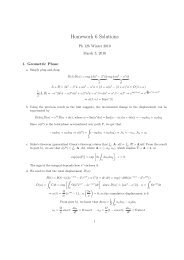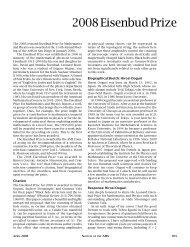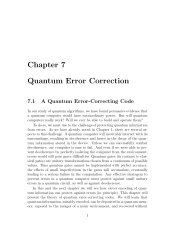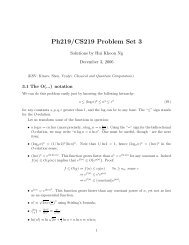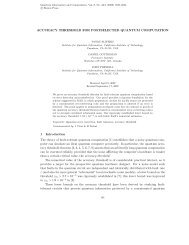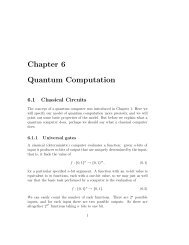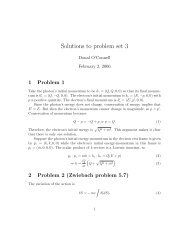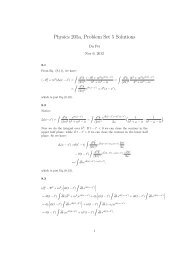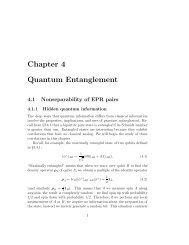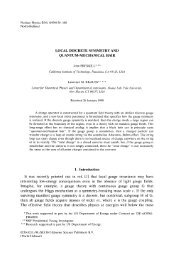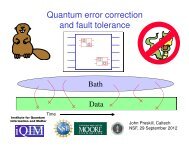Black hole - Caltech Theoretical Particle Physics
Black hole - Caltech Theoretical Particle Physics
Black hole - Caltech Theoretical Particle Physics
Create successful ePaper yourself
Turn your PDF publications into a flip-book with our unique Google optimized e-Paper software.
<strong>Black</strong> <strong>hole</strong><br />
General relativity predicts that when a massive body is compressed to sufficiently<br />
high density, it becomes a black <strong>hole</strong>, an object whose gravitational pull is so powerful<br />
that nothing can escape from it. Such objects are of great astrophysical interest, as,<br />
for example, the presumed engines that power quasars. But apart from their astrophysical<br />
implications, black <strong>hole</strong>s are of great intrinsic theoretical interest. Although<br />
in classical physics a black <strong>hole</strong> is unable to shed any of its mass, quantum effects<br />
allow it to radiate and lose energy. This black <strong>hole</strong> “evaporation” poses a great potential<br />
paradox. Nothing seems to prevent the black <strong>hole</strong> from radiating away all of<br />
its mass and disappearing completely. Thus, all information about the object from<br />
which the black <strong>hole</strong> formed seems to become forever inaccessible.<br />
It is not yet firmly established that black <strong>hole</strong>s really destroy information in this<br />
way. But if they do, we face the daunting task of finding a new conceptual basis for<br />
all of physics. Conceivably, the discovery of black <strong>hole</strong> radiance portends a scientific<br />
revolution as profound as those that led to the formulation of relativity and quantum<br />
theory in the early 20th century.<br />
<strong>Black</strong> <strong>hole</strong> thermodynamics. In classical general relativity, a black <strong>hole</strong> can<br />
be characterized as a “region of no escape” bounded by a surface known as an “event<br />
horizon.” Whoever falls through the horizon is unable to return to the region outside<br />
the black <strong>hole</strong>, or even to send any signal that can propagate to an observer outside.<br />
In fact, general relativity predicts that one who enters the black <strong>hole</strong> is inexorably<br />
driven to a “singularity,” a region of infinite spacetime curvature and hence infinitely<br />
strong gravitational forces. The singularity signifies the breakdown of classical physics<br />
deep inside the black <strong>hole</strong>. Quantum effects become important there, and classical<br />
general relativity cannot predict what will happen.<br />
The time–independent black <strong>hole</strong> solutions to the classical field equations of general<br />
relativity can be characterized by just a few parameters; a solution is uniquely<br />
1
determined once its mass, angular momentum, electric charge, and magnetic charge<br />
are specified. Thus, although the collapse of a star to form a black <strong>hole</strong> may be a<br />
very complex process, the end result is a remarkably simple object with very little<br />
structure. Once the collapsing body settles down to a stationary state, all detailed<br />
information about the body has become completely inaccessible to an observer who<br />
stays outside the black <strong>hole</strong>. “A black <strong>hole</strong> has no hair.”<br />
In the case of a nonrotating, uncharged black <strong>hole</strong>, the event horizon is a sphere;<br />
its radius R is related to its mass M according to<br />
R = 2GM<br />
c 2 , (1)<br />
where G is Newton’s gravitational constant, and c is the speed of light. (R is defined<br />
by A = 4πR 2 , where A is the area of the horizon.) Thus, a black <strong>hole</strong> of one<br />
solar mass has a radius of about 3 kilometers. According to the “area theorem” of<br />
general relativity, the total area of all event horizons can never decrease in any process<br />
involving any number of black <strong>hole</strong>s. This result (along with conservation of energy)<br />
implies that a black <strong>hole</strong> cannot split up into smaller black <strong>hole</strong>s. In classical general<br />
relativity, a (nonrotating) black <strong>hole</strong> is an absolutely stable object—it can accrete<br />
matter to become larger and heavier, but nothing can make it smaller and lighter.<br />
(Rotating black <strong>hole</strong>s can lose energy by spinning down, which accounts for some of<br />
their interesting astrophysical effects.)<br />
When quantum effects are included, this statement must be modified—a black<br />
<strong>hole</strong> can emit radiation and lose mass. In fact, semiclassical calculations show that<br />
the black <strong>hole</strong> emits like a thermal body with a characteristic temperature. For a<br />
nonrotating black <strong>hole</strong> of radius R, this temperature T is given by<br />
k B T = ¯hc<br />
4πR =<br />
¯hc3<br />
8πGM , (2)<br />
where k B is Boltzman’s constant, and ¯h is Planck’s constant. Thus, the typical<br />
radiation quanta emitted by the black <strong>hole</strong> have a wavelength comparable to R. For<br />
a solar mass black <strong>hole</strong>, the temperature is T = 6 × 10 −8 ◦ K.<br />
2
Since the emission is thermal, a black <strong>hole</strong> surrounded by a radiation bath at<br />
temperature T remains in equilibrium—it emits and absorbs at equal rates. Although<br />
this equilibrium is actually unstable, emission or accretion of radiation at temperature<br />
T can nonetheless be regarded as a reversible thermodynamic process, and the entropy<br />
of a black <strong>hole</strong> can therefore be computed (up to an unknown additive constant). The<br />
result is<br />
S/k B = 1 4<br />
A<br />
L 2 Planck<br />
, (3)<br />
where A is the area of the horizon, and L Planck ≡ (¯hG/c 3 ) 1/2 ∼ 10 −33 cm is the<br />
“Planck length” that can be constructed<br />
from the fundamental constants. Thus, the “area theorem” of classical general<br />
relativity can be regarded as a special case of the second law of thermodynamics,<br />
which says that entropy is always nondecreasing. Indeed, the analogy between the<br />
area theorem and the second law had inspired Jacob Bekenstein to anticipate eq. (3)<br />
(up to a then unknown multiplicative constant of order one) even before Stephen<br />
Hawking discovered that black <strong>hole</strong>s radiate. The entropy of a black <strong>hole</strong> is truly<br />
enormous—about 10 78 for a solar mass <strong>hole</strong>, some 20 orders of magnitude larger than<br />
the entropy of the sun.<br />
Information Loss? The discovery of black <strong>hole</strong> radiance established a deep and<br />
satisfying connection between gravitation, quantum theory, and thermodynamics.<br />
But it also raised some disturbing puzzles. One puzzle concerns the interpretation of<br />
the black <strong>hole</strong> entropy. In other contexts, the statistical–mechanical entropy counts<br />
the number of accessible microstates that a system can occupy, where all states are<br />
presumed to occur with equal probability. If a black <strong>hole</strong> really has no (or very little)<br />
hair, the nature of these microstates is obscure. Eq. (3) invites us to construe the<br />
horizon as a quantum membrane with about one degree of freedom per Planck unit<br />
of area. But a more concrete conception of these degrees of freedom remains elusive.<br />
Even more distressing is a serious paradox raised by Stephen Hawking. In his<br />
semiclassical calculation of black <strong>hole</strong> radiance, Hawking found that the emitted ra-<br />
3
diation is exactly thermal. In particular, the detailed form of the radiation does not<br />
depend on the detailed structure of the body that collapsed. This is because the<br />
radiance is induced by the gravitational field of the black <strong>hole</strong> outside the horizon,<br />
and the black <strong>hole</strong> has no hair that records detailed information about the collapsing<br />
body. While the semiclassical approximation used by Hawking is not exact, it<br />
is highly plausible that a more accurate treatment would still find that the emitted<br />
radiation is only very weakly correlated with the state of the collapsing body. The<br />
key constraint comes from causality—once the collapsing body is behind the horizon,<br />
it is incapable of influencing the radiation.<br />
Thermal radiation is in a “mixed” state, not a “pure” state. This means that the<br />
state of the radiation cannot be precisely predicted; we can only assign probabilities<br />
to different alternatives. But according to the laws of quantum mechanics, if the<br />
initial state of a system is “pure” (precisely known), then the state remains pure at<br />
later times. Information is never destroyed in principle (although information often is<br />
lost in practice). An observer outside a black <strong>hole</strong> who detects the emitted radiation<br />
would recover little information about the body that collapsed to form the black <strong>hole</strong>.<br />
Since information is conserved in principle, this observer would conclude that most<br />
of the information about the initial body must be retained inside the black <strong>hole</strong>.<br />
But suppose that the black <strong>hole</strong> continues to evaporate until it disappears completely.<br />
Then it seems that an initially pure quantum state, by collapsing to form a<br />
black <strong>hole</strong> and evaporating completely, has evolved to a mixed state. In other words,<br />
even if the initial state were precisely known, we are not able to predict with certainty<br />
what the final state will be. We can only assign probabilities to different alternatives.<br />
This is the “information loss paradox.” The paradox is that if we try to analyze the<br />
evolution of a black <strong>hole</strong> using the usual principles of relativity and quantum theory,<br />
we are led to a contradiction, for these principles forbid the evolution of a pure state<br />
to a mixed state.<br />
Hawking concludes that the usual rules of quantum mechanics cannot apply in all<br />
situations, which means that the fundamental laws of physics must be reformulated. Is<br />
4
there no way to escape this radical conclusion? It is conceivable that the semiclassical<br />
calculations are misleading, and that detailed information about the collapsing body<br />
really is encoded in the emitted radiation. But, as noted above, it is difficult to<br />
reconcile this possibility with causality, since the collapsing body is out of causal<br />
contact with the radiation once the body crosses the horizon.<br />
Other ways of evading the paradox have been suggested, but all seem to have<br />
serious flaws. As a black <strong>hole</strong> evaporates and shrinks, it eventually becomes so small<br />
that the semiclassical picture of the evaporation process no longer applies. Our usual<br />
notions of causality, and indeed the very concepts of space and time, break down<br />
at distances comparable to L Planck ; at this distance scale, spacetime is subject to<br />
violent quantum fluctuations. Because these quantum gravity effects are not well<br />
understood, one is free to speculate about how a black <strong>hole</strong> with radius R ∼ L Planck<br />
would behave.<br />
Perhaps it stops evaporating, leaving behind an absoulutely stable black <strong>hole</strong><br />
remnant. Such a remnant could serve as repository for most of the information<br />
about the collapsing body, thus resolving the paradox. But the cure may be worse<br />
than the disease. Since the initial black <strong>hole</strong> could have been arbitrarily massive,<br />
the remnant must be capable of carrying an arbitrarily large amount of information.<br />
This means that there must be an infinite number of species of stable remnant,<br />
all with size comparable to L Planck , and mass comparable to the Planck mass<br />
M Planck = (¯hc/G) 1/2 ∼ 10 −5 g. Most likely, a theory that admits this kind of infinite<br />
degeneracy does not make sense, because the calculated rates for many otherwise<br />
plausible processes are found to be infinite.<br />
Perhaps when the black <strong>hole</strong> shrinks down to the Planck size, the information<br />
that has been stored in it can finally leak out. But if the amount of information is<br />
large, it is impossible for it to come out quickly. There are fundamental limits to the<br />
amount of information that can be encoded in a Planck energy’s worth of radiation<br />
in a finite time—the more information, the longer the time. So, there would need<br />
to be Planck size black <strong>hole</strong>s that are arbitrarily long lived, even if no given species<br />
5
is absolutely stable. This scenario then runs into the same difficulties as the stable<br />
remnants.<br />
Outlook. So far, all attempts to reconcile the evaporation of black <strong>hole</strong>s with<br />
the conventional laws of physics have failed. It seems increasingly likely that the<br />
information loss paradox presages a new scientific revolution. The final outcome<br />
cannot now be safely predicted, nor can the depth of the revolution be clearly foreseen.<br />
But the puzzle of black <strong>hole</strong> evaporation remains one of the most important and<br />
challenging at the frontier of fundamental physics.<br />
John Preskill<br />
Bibliography. J. D. Bekenstein, <strong>Black</strong>–<strong>hole</strong> thermodynamics, Phys. Today.,<br />
33(1):24-31, 1980; N. D. Birrell and P. C. W. Davies, Quantum Fields in Curved<br />
Space, Cambridge, 1982; S. W. Hawking, The quantum mechanics of black <strong>hole</strong>s, Sci.<br />
Amer. 236(1):34-40, 1977; S. W. Hawking, A Brief History of Time, Bantam, 1988.<br />
6



